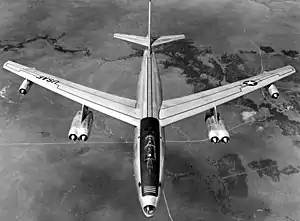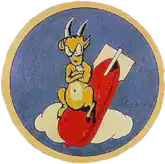| 323d Strategic Reconnaissance Squadron | |
|---|---|
 Boeing RB-47E Stratojet as flown by the squadron | |
| Active | 1942–1945; 1947–1948; 1949–1957 |
| Country | |
| Branch | |
| Role | Strategic reconnaissance |
| Engagements | European Theater of Operations |
| Decorations | Distinguished Unit Citation Air Force Outstanding Unit Award |
| Insignia | |
| 323d Strategic Reconnaissance Squadron emblem[note 1][1][note 2] |  |
| 323d Bombardment Squadron emblem[2] |  |
| World War II fuselage code[2] | OR |
The 323d Strategic Reconnaissance Squadron is an inactive United States Air Force unit. Its last was assigned to the 91st Strategic Reconnaissance Wing, stationed at Lockbourne Air Force Base, Ohio. It was inactivated on 8 November 1957.
The squadron was first activated in 1942 as the 323d Bombardment Squadron. After training in the United States, it moved to the European Theater of Operations, where it participated in the strategic bombing campaign against Germany. It was awarded two Distinguished Unit Citations for combat in Germany. Following V-E Day, the squadron returned to the United States and was inactivated in late 1945.
The squadron was redesignated the 323d Strategic Reconnaissance Squadron and activated at McGuire Air Force Base, New Jersey in 1947. Squadron elements deployed and again saw combat during the Korean War. It was inactivated at Lockbourne Air Force Base, Ohio in November 1957.
History
World War II
Organization and training in the United States
The squadron was first activated on 15 April 1942 at Harding Field as the 323rd Bombardment Squadron, one of the three original bombardment squadrons of the 91st Bombardment Group.[note 3] It was equipped with the Boeing B-17 Flying Fortress. It completed First Phase training at MacDill Field under Third Air Force, with Second and Third Phase training at Walla Walla Army Air Field under Second Air Force in Washington.[3][4] The squadron's ground echelon left for Fort Dix in early September 1942, then boarded the RMS Queen Mary for transport to England. The air echelon moved to Gowen Field, Idaho on 24 August 1942, and began receiving new B-17s there. It becan flying them from Dow Field, Maine in September, although it was not fully equipped with new aircraft until October.[1][4]
Combat in Europe
_-_NARA_-_292573.tif.jpg.webp)

The ground echelon was established temporarily at RAF Kimbolton by 13 September 1942. However, the runways at Kimbolton were not up to handling heavy bombers,[5] and the unit moved to what would be its permanent station in the European Theater of Operations, RAF Bassingbourn, on 14 October 1942.[1] Bassingbourn had been a prewar Royal Air Force station, so the squadron found itself in more comfortable quarters than most of its contemporaries.[5] The squadron primarily engaged in the strategic bombing campaign against Germany, and flew its first mission on 7 November, an attack against submarine pens at Brest, France.[4][6]
Until the middle of 1943, The squadron concentrated its attacks on naval targets, including submarine pens, dockyards, ship construction facilities and harbors, although it also struck airfields, factories, and communications facilities. On 27 January 1943, the unit attacked the Kriegsmarine yard at Wilhelmshaven as part of the first penetration by bombers of VIII Bomber Command to a target in Germany. On 4 March 1943, it attacked marshalling yards at Hamm, Germany despite adverse weather and heavy enemy opposition. For this action, it was awarded its first Distinguished Unit Citation (DUC).[6]
From the middle of 1943 to the end of the war, the squadron concentrated on attacks on German aviation, including attacks on aircraft factories, including ones at Oranienburg and Brussels; airfields at Oldenburg and Villacoublay; the ball bearing plants at Schweinfurt; chemical plants at Leverkusen and Peenemunde; and industrial facilities in Ludwigshafen, Frankfurt am Main and Wilhemshaven. As part of this attack on the German aircraft industry, on 11 January, the squadron penetrated into central Germany, despite bad weather, poor fighter cover, and strong attacks by enemy interceptor aircraft, the unit succeeded in bombing its target, earning a second DUC.[6]
The squadron also performed interdiction and air support missions. It helped prepare for Operation Overlord, the invasion of Normandy, by bombing gun emplacements and troop concentrations near the beachhead area. It aided Operation Cobra, the breakout at Saint Lo, in July 1944 by attacking enemy troop positions. It supported troops on the front lines near Caen in August 1944 and attacked lines of communications near the battlefield during the Battle of the Bulge in December 1944 and January 1945. It attacked airfields, bridges, and railroads to support Operation Lumberjack, the push across the Rhine in Germany, in 1945.[6]
Following V-E Day, the squadron evacuated prisoners of war from German camps. The first B-17 left Bassingbourn for the United States on 27 May 1945. The ground echelon sailed aboard the RMS Queen Elizabeth on 24 June 1945. The squadron was reestablished at Drew Field, Florida in early July, with the intention of deploying it to the Pacific, but it was not fully manned or equipped, and inactivated on 7 November 1945.[4][6][1]
Cold War
Reactivated in 1947 as a Strategic Air Command long-range strategic reconnaissance squadron; not manned or equipped until July 1948. Used B-17 and B-29 bombers refitted for reconnaissance missions. Deployed to Japan in 1950, and performed strategic reconnaissance missions over Korea, and the Northern Pacific coast of Communist China and the Soviet Union. Re-equipped with North American RB-45C Tornado jet reconnaissance aircraft, flying reconnaissance and mapping combat missions over Korea until being assigned to the United States in mid 1952. Re-equipped with Boeing RB-47E Stratojets, performed various reconnaissance missions on a worldwide scale until inactivation in 1957.
Lineage
- Constituted as the 323d Bombardment Squadron (Heavy) on 28 January 1942
- Activated on 15 April 1942
- Redesignated 323d Bombardment Squadron, Heavy on 20 August 1943[7]
- Inactivated on 7 November 1945
- Redesignated 323d Reconnaissance Squadron on 11 June 1947
- Activated on 1 July 1947
- Inactivated on 10 November 1948
- Activated on 1 June 1949
- Redesignated: 323d Strategic Reconnaissance Squadron, Medium on 6 July 1950
- Inactivated on 8 November 1957[8]
Assignments
- 91st Bombardment Group, 15 April 1942 – 7 November 1945
- 91st Reconnaissance Group (later 91st Strategic Reconnaissance) Group, 1 July 1947 (attached to 55th Strategic Reconnaissance Wing 19 September – 10 October 1949, 91st Strategic Reconnaissance Wing after 10 February 1951)
- 91st Strategic Reconnaissance Wing, 28 May 1952 – 8 November 1957[1]
Stations
- Harding Field, Louisiana, 15 April 1942
- MacDill Field, Florida, 13 May 1942
- Walla Walla Army Air Base, Washington, 22 June-24 August 1942
- RAF Kimbolton (AAF-117),[9] England, 13 September 1942
- RAF Bassingbourn (AAF-121),[9] England, 14 October 1942 – 22 June 1945
- Drew Field, Florida, 3 July-7 November 1945
- Andrews Field (later Andrews Air Force Base), Maryland, 1 July 1947
- McGuire Air Force Base, New Jersey, 19 July – 10 November 1948
- McGuire Air Force Base, New Jersey, 1 June 1949
- Forbes Air Force Base, Kansas, 19 September 1949
- Barksdale Air Force Base, Louisiana, 10 October 1949
- Lockbourne Air Force Base, Ohio, 11 September 1951 – 8 November 1957[1]
Aircraft
- Boeing B-17 Flying Fortress, 1942–1945, 1949
- Boeing RB-17 Flying Fortress, 1948–1949
- Boeing B-29 Superfortress, 1949–1950
- Boeing RB-29 Superfortress, 1949–1950
- North American B-45 Tornado, 1950–1953
- North American RB-45C Tornado, 1950–1953
- Boeing RB-47E Stratojet, 1953–1957[1]
Awards and campaigns
| Award streamer | Award | Dates | Notes |
|---|---|---|---|
| Presidential Unit Citation | Hamm, Germany 4 March 1943 | 323rd Bombardment Squadron[1] | |
| Presidential Unit Citation | Germany, 11 January 1944 | 323rd Bombardment Squadron[1] | |
| Air Force Outstanding Unit Award | 8 September 1953–8 November 1957 | 323rd Strategic Reconnaissance Squadron[1] |
| Campaign Streamer | Campaign | Dates | Notes |
|---|---|---|---|
| Air Offensive, Europe | 13 September 1942–5 June 1944 | 323rd Bombardment Squadron[1] | |
| Air Combat, EAME Theater | 13 September 1942–11 May 1945 | 323rd Bombardment Squadron[1] | |
| Normandy | 6 June 1944–24 July 1944 | 323rd Bombardment Squadron[1] | |
| Northern France | 25 July 1944–14 September 1944 | 323rd Bombardment Squadron[1] | |
| Rhineland | 15 September 1944–21 March 1945 | 323rd Bombardment Squadron[1] | |
| Ardennes-Alsace | 16 December 1944–25 January 1945 | 323rd Bombardment Squadron[1] | |
| Central Europe | 22 March 1944–21 May 1945 | 323rd Bombardment Squadron[1] |
References
Notes
- Explanatory notes
- ↑ Approved 23 October 1953.
- ↑ Description: On a blue disc and eagle (grey with white head and tail and yellow beak and feet) in flight and carrying a red serial bomb in his right foot and a black camera in his left with wings extending over a crescent shaped cloud formation issuing from a white ram jet with red exhaust in dexter chief and extending downwards around the disc and ending over a yellow spinning globe (with grey-blue land areas, black longitude and latitude lines and white speed lines) in center base. Maurer, Combat Squadrons, p. 397.
- ↑ The group was also assigned a reconnaissance squadron, but this unit was quickly redesignated as the group's fourth bombardment squadron. Maurer, Combat Squadrons, pp. 490–491
- ↑ Aircraft is Boeing B-17F-5-BO Flying Fortress, serial 41-24399. This aircraft was shot down by Hauptmann Johannes Naumann in a FW-190A-6 of 6 Staffel/Jagdgeschwader 26 on a mission to Kassel, Germany, crashing at Opijnen, Netherlands on 30 July 1943. Eight of the crew were killed, two became prisoners. (MACR 148).
- ↑ This aircraft is Boeing B-17F-30-BO Flying Fortress, serial 42-5077. This plane was shot down on a 12 August 1943 mission to Gelsenkirchen, Germany. It was damaged first by Hauptmann Johannes Naumann, then shot down by Oberfeldwebel Adolf Glunz of 4 Staffel/Jagdgeshwader 26 in a FW-190A-5 over Brunninghausen, Germany. Four of the crew were killed, 6 became prisoners of war. (MACR 261).
- Citations
- 1 2 3 4 5 6 7 8 9 10 11 12 13 14 15 16 17 Maurer, Combat Squadrons, p. 397
- 1 2 Watkins, pp. 34-35
- ↑ Lahue, Melissa (1 September 2022). "Factsheet 90 Operations Group (AFSPC)". Air Force Historical Research Agency. Retrieved 6 January 2023.
- 1 2 3 4 Freeman, pp. 243-244
- 1 2 Freeman, p. 20
- 1 2 3 4 5 Maurer, Combat Units, pp. 156-158
- ↑ See Robertson, Patsy (30 July 2012). "Factsheet 322 Expeditionary Reconnaissance Squadron (ACC)". Air Force Historical Research Agency. Retrieved 11 November 2015. (redesignation of 91st Group squadron)
- ↑ Lineage in Maurer, Combat Squadrons, p. 397, except as noted
- 1 2 Station number in Anderson, p. 20
Bibliography
![]() This article incorporates public domain material from the Air Force Historical Research Agency
This article incorporates public domain material from the Air Force Historical Research Agency
- Anderson, Capt. Barry (1985). Army Air Forces Stations: A Guide to the Stations Where U.S. Army Air Forces Personnel Served in the United Kingdom During World War II (PDF). Maxwell AFB, AL: Research Division, USAF Historical Research Center. Archived from the original (PDF) on 4 March 2016. Retrieved 7 July 2012.
- Freeman, Roger A. (1970). The Mighty Eighth: Units, Men and Machines (A History of the US 8th Army Air Force). London, England, UK: Macdonald and Company. ISBN 978-0-87938-638-2.
- Maurer, Maurer, ed. (1983) [1961]. Air Force Combat Units of World War II (PDF) (reprint ed.). Washington, DC: Office of Air Force History. ISBN 0-912799-02-1. LCCN 61060979.
- Maurer, Maurer, ed. (1982) [1969]. Combat Squadrons of the Air Force, World War II (PDF) (reprint ed.). Washington, DC: Office of Air Force History. ISBN 0-405-12194-6. LCCN 70605402. OCLC 72556.
- Ravenstein, Charles A. (1984). Air Force Combat Wings, Lineage & Honors Histories 1947–1977. Washington, DC: Office of Air Force History. ISBN 0-912799-12-9.
- Watkins, Robert (2008). Battle Colors: Insignia and Markings of the Eighth Air Force In World War II. Vol. I (VIII) Bomber Command. Atglen, PA: Shiffer Publishing Ltd. ISBN 978-0-7643-1987-7.